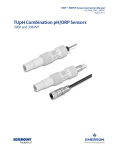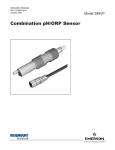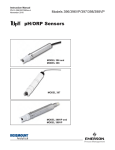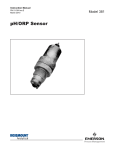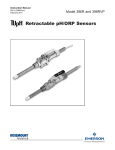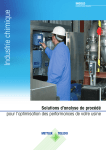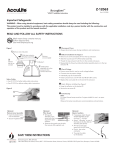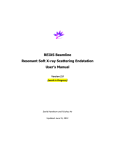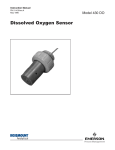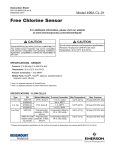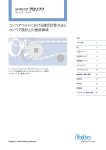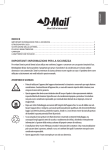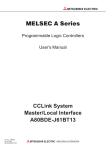Download Emerson Process Management 396P Stereo System User Manual
Transcript
Instruction Manual
PN 51-396P/rev.H
March 2006
Models 396P and 396PVP
Combination pH/ORP Sensor
MODEL 396P
MODEL 396PVP
with mating cable
DANGER
HAZARDOUS AREA
INSTALLATION
ESSENTIAL INSTRUCTIONS
READ THIS PAGE BEFORE PROCEEDING!
Rosemount Analytical designs, manufactures, and tests its products to meet
many national and international standards. Because these instruments are
sophisticated technical products, you must properly install, use, and maintain
them to ensure they continue to operate within their normal specifications. The
following instructions must be adhered to and integrated into your safety program when installing, using, and maintaining Rosemount Analytical products.
Failure to follow the proper instructions may cause any one of the following situations to occur: Loss of life; personal injury; property damage; damage to this
instrument; and warranty invalidation.
• Read all instructions prior to installing, operating, and servicing the product.
If this Instruction Manual is not the correct manual, telephone 1-800-6547768 and the requested manual will be provided. Save this Instruction
Manual for future reference.
• If you do not understand any of the instructions, contact your Rosemount
representative for clarification.
• Follow all warnings, cautions, and instructions marked on and supplied with
the product.
• Inform and educate your personnel in the proper installation, operation, and
maintenance of the product.
• Install your equipment as specified in the Installation Instructions of the
appropriate Instruction Manual and per applicable local and national codes.
Connect all products to the proper electrical and pressure sources.
• To ensure proper performance, use qualified personnel to install, operate,
update, program, and maintain the product.
• When replacement parts are required, ensure that qualified people use
replacement parts specified by Rosemount. Unauthorized parts and procedures can affect the product’s performance and place the safe operation of
your process at risk. Look alike substitutions may result in fire, electrical
hazards, or improper operation.
This sensor is not Intrinsically Safe. or Explosion
Proof. Installations near flammable liquids or in
hazardous area locations must be carefully evaluated by qualified on site safety personnel.
To secure and maintain an intrinsically safe
installation, an appropriate transmitter/ safety
barrier/sensor combination must be used. The
installation system must be in accordance with
the governing approval agency (FM, CSA or
BASEEFA/CENELEC) hazardous area classification requirements. Consult your analyzer/
transmitter instruction manual for details.
Proper installation, operation and servicing of
this sensor in a Hazardous Area Installation is
entirely the responsibility of the user.
CAUTION
SENSOR/PROCESS
APPLICATION COMPATIBILITY
The wetted sensor materials may not be
compatible with process composition and
operating
conditions.
Application
compatibility is entirely the responsibility
of the user.
About This Document
This manual contains instructions for installation and operation of the Models 396P and 396PVP
TUpH Combination pH/ORP Sensors. The following list provides notes concerning all revisions of
this document.
Rev. Level
Date
0
8/95-2/01
A
12/01
Notes
This is the initial release of the product manual. The manual has been reformatted to reflect the
Emerson documentation style and updated to reflect any changes in the product offering.
Added wiring diagram to page 14.
B
4/02
Revised drawings on pages 6, 7, and 14.
C
7/02
Added 1055 wiring diagrams.
D
8/03
Added Silcore information.
E
5/04
Added 5081 and Xmt wiring info. Deleted obsolete model information.
G
11/05
Changed Figure 4-6 drawing on page 17. Resized Figure 1-1 drawing on page 2.
H
3/06
Changed PN on Fig. 2-5, page 8, and in Table 7-3, page 29. Added a note on page 11.
Emerson Process Management
Liquid Division
2400 Barranca Parkway
Irvine, CA 92606 USA
Tel: (949) 757-8500
Fax: (949) 474-7250
http://www.raihome.com
© Rosemount Analytical Inc. 2006
MODEL 396P and 396PVP
TABLE OF CONTENTS
MODEL 396P and 396PVP
COMBINATION pH/ORP SENSOR
TABLE OF CONTENTS
Section
1.0
1.1
1.2
1.3
Title
DESCRIPTION AND SPECIFICATIONS.................................................................
Features and Applications........................................................................................
Physical Specifications.............................................................................................
Ordering Information ................................................................................................
Page
1
1
2
3
2.0
2.1
2.2
INSTALLATION .......................................................................................................
Unpacking and Inspection........................................................................................
Mounting ..................................................................................................................
5
5
5
3.0
WIRING MODEL 396P-01 .......................................................................................
10
4.0
WIRING MODELS 396P-02 AND 396PVP..............................................................
16
5.0
5.1
5.2
START UP AND CALIBRATION .............................................................................
Model 396P pH ........................................................................................................
Model 396P ORP .....................................................................................................
24
24
24
6.0
6.1
6.2
6.3
MAINTENANCE ......................................................................................................
Automatic Temperature Compensator .....................................................................
Model 396P pH ........................................................................................................
Model 396P ORP .....................................................................................................
25
25
25
26
7.0
7.1
27
7.2
DIAGNOSTICS AND TROUBLESHOOTING..........................................................
Diagnostics & Troubleshooting With the Models 54e, 1055, 3081, 81, 4081, 5081.
and Xmt....................................................................................................................
Troubleshooting Without Advanced Diagnostics......................................................
27
28
8.0
RETURN OF MATERIAL.........................................................................................
30
LIST OF TABLES
Number
1-1
3-1
4-1
5-1
6-1
6-2
7-1
7-2
7-3
Title
Recommended Accessories for First Time Installations ...........................................
Wiring Matrix Guide - Model 396P ...........................................................................
Wiring Matrix Guide - Model 396PVP.......................................................................
ORP of Saturated Quinhydrone Solution (In Millivolts).............................................
Ro and R1 Values for Temperature Compensation Elements ..................................
Temperature vs Resistance of Auto T.C. Elements ..................................................
Troubleshooting With Advanced Diagnostics ...........................................................
Troubleshooting Without Advanced Diagnostics ......................................................
Model 396P Replacement Parts and Accessories....................................................
i
Page
4
10
16
24
25
25
27
28
29
MODEL 396P and 396PVP
TABLE OF CONTENTS
LIST OF FIGURES
Number Title
Page
1-1
Cross Section Diagram of the TUpH Patented Reference Technology ...............................................................................
2
2-1
Dimensional Drawing ..........................................................................................................................................................
6
2-2
Flow-Through Tee with Adapter (PN 915240-xx).................................................................................................................
6
2-3
Flow-Through and Insertion Installations ...........................................................................................................................
7
2-4
Model 396P/396PVP with Insertion Mounting Adapter (PN 23242-02) ...............................................................................
7
2-5
Submersion Installations ....................................................................................................................................................
8
2-6
Low Flow Cell PN 23728-00................................................................................................................................................
9
2-7
Jet Spray Cleaner PN 12707-00..........................................................................................................................................
10
3-1
Wire Functions for Model 396P with & without Preamplifier................................................................................................
10
3-2
Wiring Details Model 396P-01-50 for use with & without Junction Box (PN 22719-02) for Models 1181, 1050, & 1060 ....
12
3-3
Wiring Details Model 396P-01-54 for use with & sithout Junction Box (PN 22719-02) for Models 1054/A/B, 2054, 2081
and Extension Cable (PN 9200254)....................................................................................................................................
13
3-4
Wiring Details Model 396P-01-55 for use with Junction Box (PN 23550-00) for Models 54, 3081, 4081, 81, and 5081 ...
14
3-5
Wiring Details Model 396P-01-55 for use with Models 54, 81, 3081, 4081, and 5081........................................................
15
3-6
Wiring Model 396P-01)-( )-55 Sensor to Model 1055-10-22-32 Analyzer ...........................................................................
15
4-1
Wire Functions for Mating Variopol Cable used with Model 396PVP ..................................................................................
17
4-2
Connector Pins and their Functions ....................................................................................................................................
17
4-3
Wiring Details for Models 396PVP or 396P-02-55 with Mating Variopol Cable (PN 23645-07) for use with Model 81 .......
17
4-4
Wiring Details for Models 396PVP or 396P-02-50 with Mating Variopol Cable (PN 23645-07) for use with Model 1181 ...
17
4-5
Wiring Details for Models 396PVP or 396P-02-54 with Mating Variopol Cable (PN 23645-07) for use with Model 2081 ...
17
4-6
Wiring Details for Models 396PVP or 396P-02-55 with Mating Variopol Cable (PN 23645-07) for use with Models 3081,
4081, and 5081 ...................................................................................................................................................................
17
4-7
Wiring Details for Models 396PVP or 396P-02-55 with Mating Variopol Cable (PN 23645-07) for use with Remote ........
Junction Box (PN 23555-00) to Model 81 ...........................................................................................................................
18
4-8
Wiring Details for Models 396PVP or 396P-02-50 with Mating Variopol Cable (PN 23645-07) for use with Remote ........
Junction Box (PN 23309-03) to Model 1181........................................................................................................................
18
4-9
Wiring Details for Models 396PVP or 396P-02-55 with Mating Variopol Cable (PN 23645-07) for use with Model 54 ......
18
4-10
Wiring Details for Models 396PVP or 396P-02-55 with Mating Variopol Cable (PN 23645-07) for use with Remote ........
Junction Box (PN 23555-00) to Model 54 ...........................................................................................................................
18
4-11
Wiring Details for Models 396PVP or 396P-02-54 with Mating Variopol Cable (PN 23645-06) for use with Remote ........
Junction Box (PN 23309-03) to Model 2081 .......................................................................................................................
19
4-12
Wiring Details for Models 396PVP or 396P-02-55 with Mating Variopol Cable (PN 23645-07) for use with Remote ........
Junction Box (PN 23555-00) to Models 3081 and 4081......................................................................................................
19
4-13
Wiring Details for Models 396PVP or 396P-02-54 with Mating Variopol Cable (PN 23645-07) for use with Model 1054 ...
19
4-14
Wiring Details for Models 396PVP or 396P-02-54 with Mating Variopol Cable (PN 23645-07) for use with ......................
Model SCL-(P/Q) .................................................................................................................................................................
19
4-15
Wiring Details for Models 396PVP or 396P-02-55 with Mating Variopol Cable (PN 23645-07) for use with Model 1055 ...
20
4-16
Wiring Model 396P-(02)-( )-54/55-(61) Sensor to Model 1055-01-10-22-32 Analyzer ........................................................
20
4-17
Wiring Details for Models 396PVP or 396P-02-55 with Mating Variopol Cable (PN 23645-07) for use with Remote ........
Junction Box (PN 23557-00) to Model 1055 .......................................................................................................................
20
4-18
Wiring Details for Models 396PVP or 396P-02-54 with Mating Variopol Cable (PN 23645-06) for use with Models ..........
1054A/B and 2054...............................................................................................................................................................
21
4-19
Wiring Details for Models 396PVP or 396P-02-54 with Mating Variopol Cable (PN 23645-06) for use with Remote ........
Junction Box (PN 23309-04) to Models 1054A/B and 2054................................................................................................
21
4-20
Wiring to Model 54e pH/ORP with Variopol........................................................................................................................
21
4-21
Wiring Details Model 396P-02-50 for use with Junction Box (PN 23309-03), Remote Preamplifier, and Extension ..........
Cable (PN 9200254)............................................................................................................................................................
22
4-22
Wiring Details Model 396P-02-54 for use with Junction Box (PN 23309-04), Remote Preamplifier (PN 22698-03), and ..
Extension Cable (PN 9200254)...........................................................................................................................................
22
4-23
Wiring Model 396P-01 to Model Xmt-P-HT-10 ...................................................................................................................
23
4-24
Wiring Models 396P-02 and 396PVP to Model Xmt-P-HT-10 ............................................................................................
23
ii
MODEL 396P and 396PVP
SECTION 1.0
DESCRIPTIONS AND SPECIFICATIONS
SECTION 1.0
DESCRIPTION AND SPECIFICATIONS
1.1 FEATURES AND APPLICATIONS
The Rosemount Analytical Model 396P and 396PVP
Sensors measure the pH or the ORP of aqueous solutions in pipelines, open tanks, or ponds. It is designed
for harsh, dirty applications such as sourwater waste
treatment and scrubbers, where a high performance,
low maintenance, disposable sensor is required.
The combination electrode features a patented, large
area polypropylene reference junction for resistance to
process coatings, generally found in dirty, high solid
applications. The patented helical reference pathway
provides added resistance for poisoning applications.
In addition, it is available in two configurations:
glass/platinum electrode completely recessed within
the reference junction for added life in abrasive or
rough applications and the glass/platinum electrode
partially exposed for added life and accuracy in viscous and low flow applications.
Both Models feature a titanium solution ground constructed in an annular design around the pH/ORP electrode. The solution ground provides glass and reference sensor diagnostics for preventative maintenance
when used with the Model 54e, 1055, 5081, 3081,
4081, 81 pH/ORP, and Xmt-P transmitters. In addition
Models 396P and 396PVP can be used with most nondiagnostic Rosemount Analytical and other manufacturer’s instruments.
Each sensor is housed in a molded polypropylene
body with EPDM seals, making it virtually indestructible and chemically resistant. Complete encapsulation
eliminates leakage or high humidity problems traditionally found in other pH/ORP designs. The simplified
construction, designed with user convenience in mind,
does not require electrolyte (KCl) replenishment or any
high maintenance troubleshooting procedures.
The Model 396P is offered with or without an optional
integral preamplifier to convert the high impedance pH
or ORP mV signal into a stable, noise-free signal with
transmission capability of up to three miles. A remote
preamplifier must be used with Model 396PVP.
Model 396PVP is offered with a watertight sensor-tocable connector which eliminates re-wiring and cable
twisting when replacing sensors. The Variopol VP
multiple pin connector is an integral part of each sensor model and uses a mating VP cable. Once the
cable is installed and wired to the analyzer, sensors
are easily replaced without replacing the cable, and, if
the replacement sensor is the same as its predecessor, without rewiring the analyzer. Also the cable can
be disconnected from the sensor before removal from
the process which eliminates cable twisting.
The entire line of TUpH model sensors now incorporate the new SILCORE technology contaminant
barrier. This triple-seal barrier prevents moisture and
material impurities from migrating to the pH sensor’s
reference electrode’s metal lead wire. By preventing
these contaminants from compromising the integrity
of the pH measurement, sensor life is increased,
especially at higher temperatures where increased
migrations occur. In addition, the SILCORE technology provides added protection against sensor failure
due to vibrations and shock by transferring damaging
energy away from the glass-to-metal seal.
The AccuGLASS pH glass formulations exceed
industry standards. The AccuGlass pH glass is a
result of many years of glass research resulting in a
formulation which has been found to increase the life
of the sensor. Unlike other pH glasses presently on
the market, this glass resists cracking especially at
higher temperatures and reduces sodium ion error
commonly found in high pH applications. Overall, the
AccuGlass formulation enhances the sensor performance to measure pH more accurately and have a
longer sensor life than ever before.
AccuGlass and Silcore are trademarks of Rosemount Analytical.
Installation is easily achieved through the wide variety
of mounting configurations. The Models 396P and
396PVP feature 1 in. (MNPT) front and rear facing
connections for insertion, submersion or flow through
pH and ORP applications.
1
MODEL 396P and 396PVP
SECTION 1.0
DESCRIPTIONS AND SPECIFICATIONS
FIGURE 1-1. Cross Section Diagram of the TUpH Patented Reference Technology
All TUpH sensors are designed with a large area reference junction, helical reference pathway, and an AccuGlass pH
glass bulb. This patented sensor technology ensures superior performance while only requiring minimal maintenance.
1.2 SPECIFICATIONS
Measurements and Ranges
Available pH ACCUGLASS Types
Wetted Materials
Process Connection
Temperature Range
Pressure Range-Hemi bulb
Pressure Range-Flat bulb
Minimum Conductivity
Integral Cable
Preamplifier Options
Weight/Shipping Weight
*pH: 0-14
ORP: -1500 to 1500 mv
GPLR hemi or flat glass
Titanium, Polypropylene, EPDM, glass; platinum (ORP only)
1 in. MNPT front and rear facing threads
0-100°C (32-212°F)
100-1135 kPa [abs] (0-150 psig)
100-790 kPa [abs] (0-100 psig)
75 μS/cm, nominal; 100 μS/cm
396P: Code 01 - 25 ft; Code 02 - 15 ft coaxial
396PVP: none - must use mating VP cable
396P: Remote or Integral
396PVP: Remote only
0.45 kg/0.9 kg (1 lb/2 lb)
PERCENT LINEARITY*
pH range
2
GPLR hemi bulb
GPLR flat bulb
0 - 2 pH
94%
—
2 - 12 pH
99%
98%
12 - 13 pH
97%
95%
13 - 14 pH
92%
—
MODEL 396P and 396PVP
SECTION 1.0
DESCRIPTIONS AND SPECIFICATIONS
1.3 ORDERING INFORMATION
The Model 396P Sensor is housed in a molded reinforced polypropylene
body with 1 in. MNPT threads suitable for insertion, submersion or flow
through installation. The sensor includes a general purpose pH electrode
or a platinum ORP electrode, a patented reference junction and a solution
ground. The Model 396P comes standard with a recessed electrode; an
optional slotted tip is also available. In addition, the 396P features an
optional integral hermetically sealed preamplifier and 15 ft or 25 ft cable
lengths. Automatic temperature compensation, Pt 100 or 3K Balco, is
standard with the Model 396P.
MODEL
396P
TUpH INSERTION/SUBMERSION POLYPROPYLENE pH/ORP SENSOR
CODE
01
PREAMPLIFIER/CABLE (Required Selection)
With integral preamplifier, 25 ft cable
02
Without integral preamplifier, 15 ft cable
CODE
10
MEASURING ELECTRODE TYPE (Required Selection)
GPLR hemi bulb, General Purpose Low Resistivity (0-14 pH)
12
ORP
13
GPLR flat bulb, General Purpose Low Resistivity (2 - 13 pH)
CODE
50
ANALYZER/TC COMPATIBILITY (Required Selection)
For Models 1181 (3K TC)
54
For Models 1054A/B, 2054, 2081 (Pt 100 RTD)
55
For Models 54e, 3081, 81, 4081, 1055, 5081, Xmt (PT-100 RTD)
CODE
41
396P
The Model 396P insertion/submersion
sensor with integral cable is offered with
or without a built-in preamplifier
OPTIONAL SELECTION
Slotted Tip (not available on flat bulb sensors)
-
01
-
10
-
55
EXAMPLE
NOTE: The Model 396P is also compatible with Model SCL-P/Q (option 02-54 only).
TABLE 1-1. RECOMMENDED ACCESSORIES FOR FIRST TIME INSTALLATIONS
1. Mounting Accessories (optional)
Choose one: PN 915240-03, PVC flow through tee, 3/4 in. NPT process connection
PN 915240-04, PVC flow through tee, 1 in. NPT process connection
PN 915240-05, PVC flow through tee, 1-1/2 in. NPT process connection
PN 23728-00, acrylic low flow cell
PN 2002011, 1-1/2 in. CPVC tee with 1-in. FNPT connection
PN 11275-01, sensor handrail assembly
2. Junction Boxes (optional)
Remote Junction Boxes (used with option -02 sensors, for sensor to analyzer distances of more than 15 ft)
Choose one: PN 23555-00 includes preamplifier for Models 54, 81, 3081, 4081, 5081, Xmt
PN 23309-03 and PN 22698-02 plug-in preamplifier for Model 1181Analyzer
PN 23309-04 and PN 22698-03 plug-in preamplifier for Models 1054A/B series, 2054, 2081 Analyzers
Choose one: PN 9120516 BNC Adapter for use with remote junction boxes PNs 23309-03, 23309-04
Remote Junction Box (used with option -01 sensors)
Choose one: PN 23550-00 cable extension board
3. Extension cables (used with remote junction boxes)
Choose one: PN 23646-01, 11 conductor, shielded, prepped
PN 9200273, 11 conductor, shielded, unprepped
3
MODEL 396P and 396PVP
SECTION 1.0
DESCRIPTIONS AND SPECIFICATIONS
The Model 396PVP Sensor has similar features to the Model 396P.
However, the Model 396PVP is offered with the new Variopol (VP)
connector and uses a mating VP cable (purchased separately).
A remote preamplifier must be used with this sensor.
A Variopol cable is required for all new installations. See below
for cable selection.
The Model 396PVP insertion/ submersion sensor with the VP (Variopol) connector
MODEL
396PVP
TUpH INSERTION/SUBMERSION POLYPROPYLENE pH/ORP SENSOR
CODE
10
MEASURING ELECTRODE TYPE (Required Selection)
GPLR hemi bulb, General Purpose Low Resistivity (0-14 pH)
12
ORP
13
GPLR flat bulb, General Purpose Low Resistivity (2 - 13 pH)
CODE
50
ANALYZER/TC COMPATIBILITY (Required Selection)
For Models 1181 (3K TC)
54
For Models 1054A/B, 2054, 2081 (Pt 100 RTD)
55
For Models 54e, 3081, 81, 4081, 1055, 5081, Xmt (PT-100 RTD)
CODE
41
OPTIONAL SELECTION
Slotted Tip (not available on flat bulb sensors)
PN
23645-06
MATING VP CONNECTOR CABLE (Required for all new installations)
15 ft. cable with mating VP connector, prepped with BNC on analyzer end
23645-07
15 ft. cable with mating VP connector, prepped without BNC on analyzer end*
*For use with connections to Models 1181, 1054A/B, 2081, 54e, 81, 3081, 4081, 5081, Xmt, and remote junction box PN 23555-00.
OTHER ACCESSORIES FOR MODELS 396P AND 396PVP
PART
22698-00
22698-02
22698-03
22743-01
22744-01
23557-00
9210012
9210013
9210014
R508-160Z
12707-00
DESCRIPTION
Preamplifier plug-in for junction box, for Model 1003,
Preamplifier plug-in for junction box, for Models 1181, 1050
Preamplifier plug-in for junction box, for Models 1054A/B, 2054, 2081
Pt100 preamplifier for Model 1181
3K Preamplifier for Model 1181
Preamplifier for junction box for Models 54, 3081, 81, 4081, 5081
Buffer solution, 4.01 pH, 16 oz
Buffer solution, 6.86 pH, 16 oz
Buffer solution, 9.18 pH, 16oz
ORP solution, 460 mv ± 10 at 20°C
Jet Spray Cleaner
Examples of all sensing tip offerings
Shrouded Tip is
standard on all
hemi bulb sensors
4
Optional Slotted Tip
is available on all
hemi bulb sensors,
ordered as option -41
Flat Tip is available with flat
glass bulb sensors
Variopol connector
shown with mating variopol
cable receptacle
MODEL 396P and 396PVP
SECTION 2.0
INSTALLATION
SECTION 2.0
INSTALLATION
2.1 UNPACKING AND INSPECTION.
Inspect the outside of the carton for any damage. If damage is detected, contact the carrier immediately. Inspect
the hardware. Make sure all the items in the packing list
are present and in good condition. Notify the factory if any
part is missing. If the sensor appears to be in satisfactory
condition, proceed to Section 2.2, Mounting.
NOTE
Save the original packing cartons and materials as most carriers require proof of damage
due to mishandling, etc. Also, if it is necessary
to return the sensor to the factory, you must
pack the sensor in the same manner as it was
received. Refer to Section 6.0 for return
instructions. If the sensor is to be stored, the
vinyl boot should be filled with pH buffer solution and replaced on sensor tip until ready to
use.
CAUTION
Buffer solution, in the vinyl boot, may cause
skin or eye irritation.
2. Do not install the sensor on the horizontal. The
sensor must be 10° off the horizontal to ensure
accuracy.
3. Do not install the sensor upside down.
4. Air bubbles may become trapped in the sensor end
between the glass bulb and the sensor body. This
problem is most commonly encountered in areas
of low flow or during calibration. Shake the probe
while immersed in solution to remove bubbles.
This problem can be avoided by ordering the sensor with the slotted tip (option -41).
In most cases, the pH sensor can simply be installed
as shipped and readings with an accuracy of ± 0.6 pH
may be obtained. To obtain greater accuracy or to verify proper operation, the sensor must be calibrated as
a loop with its compatible analyzer or transmitter.
2.2.1 Flow Through and Insertion Mounting.
Model 396P and 396PVP Sensors have a 1-inch
MNPT process connection at the front of the sensor for
mounting into a 1-1/2 inch tee or the process pipes.
See Figure 2-1 through Figure 2-7 for installation configurations.
NOTE
LARGE PIPE WRENCHES MUST NOT BE
USED TO TIGHTEN THE SENSOR INTO A
FLANGE OR OTHER TYPE OF MOUNTING.
WARNING
Glass electrode must be wetted at all times (in
storage and in line) to maximize sensor life.
2.2 MOUNTING.
The sensor has been designed to be located in industrial process environments. Temperature and pressure
limitations must not be exceeded at any time. A caution
label regarding this matter is attached to the sensor.
Please do not remove the label. See Figure 2-1.
CAUTION
Internal electrolyte fill solution may cause skin
or eye irritation.
Mounting Guidelines:
1. Shake the sensor in a downward motion to
remove any air bubbles that may be present inside
the tip of the pH glass.
2.2.2 Submersion Mounting. Model 396P and
396PVP Sensors also have a 1 inch MNPT process
connection at the back of the sensor. Utilizing a standard 1 inch union, the sensor may be mounted to a 1
inch SCH 80 CPVC or PVDF standpipe (see Figure 2x). Tapered pipe threads in plastic tend to loosen after
installation. It is therefore recommended that Teflon1
tape be used on the threads and that the tightness of
the connection be checked frequently to assure that no
loosening has occurred. To prevent rain water or condensation from running into the sensor, a weatherproof
junction box is recommended (see Figure 2-x). The
sensor cable must be run through a protective conduit
for isolation from electrical interference or physical
abuse from the process. The sensor should be installed
within 80° of vertical, with the electrode facing down.
The sensor’s cable should not be run with power or
control wiring.
1
Teflon is a registered trademark of E.I. du Pont de Nemours & Co.
5
MODEL 396P and 396PVP
SECTION 2.0
INSTALLATION
SENSOR CABLE
(OR VP CONNECTOR
- NOT SHOWN)
MILLIMETER
INCH
DWG. NO.
40396P01
FIGURE 2-1. Dimensional Drawing
MILLIMETER
INCH
xx*
03
04
05
SENSOR CABLE (OR VP CONNECTOR - NOT SHOWN)
Process Connection
Threads
3/4 inch
1 inch
1-1/2 inch
FIGURE 2-2. Flow-Through Tee with Adapter (PN 915240-xx*)
6
REV.
D
MODEL 396P and 396PVP
SECTION 2.0
INSTALLATION
WHEN INCH AND METRIC DIMS
ARE GIVEN
MILLIMETER
INCH
1-1/2” X 1”
Reducing
Bushing
1-1/2” X 1”
Reducing
Bushing
1-1/2” Pipe Tee
PN 2002011
ANGLE
FLOW
SHOWN
FLOW
STRAIGHT
FLOW
SHOWN
1-1/2” Pipe Tee
PN 2002011
1-1/2” X 1”
Reducing
Bushing
PIPE “Y”
INSTALLATION
SHOWN
1-1/2” PIPE “Y”
FIGURE 2-3. Flow-Through and Insertion Installations
DWG. NO.
40396P02
REV.
A
FIGURE 2-4. Model 396P with Insertion Mounting Adapter (PN 23242-02).
Not for use with Model 396PVP.
Mounting adapter allows for sensor removal without twisting or
disconnecting interconnecting cable for ease of maintenance.
7
MODEL 396P and 396PVP
SECTION 2.0
INSTALLATION
WHEN INCH AND METRIC DIMS
ARE GIVEN
MILLIMETER
INCH
DWG. NO.
40396P03
REV.
A
Handrail Mounting
Assembly PN 11275-01
DWG. NO.
40396P04
FIGURE 2-5. Submersion Installations
8
REV.
A
MODEL 396P and 396PVP
MILLIMETER
INCH
SECTION 2.0
INSTALLATION
SENSOR CABLE
(OR VP CONNECTOR
- NOT SHOWN)
FIGURE 2-6. Low Flow Cell PN 23728-00
FIGURE 2-7. Jet Spray Cleaner PN 12707-00
9
MODEL 396P and 396PVP
SECTION 3.0
WIRING - MODEL 396P
SECTION 3.0
WIRING — MODEL 396P-01
Figures in this section provide the guidelines for wiring
the 396P-01 sensor to various Analyzer/Transmitter
instruments.
2.
To determine which wiring guideline to use, locate the
model number of the sensor to be installed.
1. If the cable needs to be extended, use a high quality eleven conductor double shielded instrument
cable available from Rosemount Analytical. Refer
to Table 3-1 for the appropriate junction box to use
and the corresponding wiring details.
Signal cable should be run in a dedicated conduit
(preferably an earth grounded metallic conduit)
and should be kept away from AC power lines. For
your convenience, a wire nut kit is furnished (in a
plastic bag wrapped around the cable).
NOTE
For maximum EMI/RFI protection when
wiring from the sensor to the junction box,
the outer braid of the sensor should be connected to the outer braided shield of the
extension cable. The outer braid of the
extension cable to the instrument must be
terminated at earth ground or by using an
appropriate metal cable gland fitting that
provides a secure connection to the instrument cable.
NOTE
If the cable is too long, loop up the excess
cable. If the cable has to be shortened, cut
and terminate each conductor neatly and
make sure that the overall (outermost)
drain wire is not shorted out with either
of the two inner drain wires (shields).
TABLE 3-1. Wiring Matrix Guide
Preamplifier Location
Sensor
Model
Options
Integral to Integral to Remote
Sensor Analyzer Junction
Box (PN)
396P-01-()-50
396P-01-()-50
396P-01-()-54
396P-01-()-54
396P-01-()-55
396P-01-()-55
396P-01-()-55
10
Analyzer/Transmitter
Interconnect
1054A,
54e, 81, 1055
(unprepped 1054B, 2054
3081,
PN)
2081
4081, 5081
Ext. box
(22719-02)
9200254
Ext. box
(22719-02)
9200254
Ext. box
(23550-00)
9200273
9200273
or 23646-01
1181
1050
1060
1003 SCL or Refer to
1023 SoluCube Figure
#
3-2
3-2
3-3
3-3
3-5
3-4
3-6
MODEL 396P and 396PVP
Wiring. The Model 396P has an optional built-in preamplifier and is offered with a shielded cable. The
cable should be handled carefully and kept dry and
free of corrosive chemicals at all times. Extreme care
should be used to prevent it from being twisted, damaged or scraped by rough, sharp edges or surfaces.
Please refer to Figures 3-1 through 3-6 for wiring
Model 396P-01.
SECTION 3.0
WIRING - MODEL 396P
DANGER
DO NOT CONNECT SENSOR CABLE TO
POWER LINES. SERIOUS INJURY MAY
RESULT.
NOTE
Remove electrical tape or shrink sleeve from gray
reference wire before connecting wire to terminal.
Model 396P
Option 01 (with
preamplifier) cable
Model 396P
Option 02 (without
preamplifier) cable
FIGURE 3-1. Wire Functions for Model 396P with and without Preamplifier
11
MODEL 396P and 396PVP
SECTION 3.0
WIRING - MODEL 396P
WHEN INCH AND METRIC DIMS
ARE GIVEN
MILLIMETER
INCH
DWG. NO.
40396P15
FIGURE 3-2. Wiring Details Model 396P-01-50 for use with and without Junction Box
(PN 22719-02) for Model 1181.
12
REV.
B
MODEL 396P and 396PVP
SECTION 3.0
WIRING - MODEL 396P
WHEN INCH AND METRIC DIMS
ARE GIVEN
MILLIMETER
INCH
DWG. NO.
40396P13
REV.
D
FIGURE 3-3. Wiring Details Model 396P-01-54 for use with and without Junction Box
(PN 22719-02) for Models 1054A, 1054B, 2054, 2081, and Extension Cable (9200254).
13
MODEL 396P and 396PVP
SECTION 3.0
WIRING - MODEL 396P
WHEN INCH AND METRIC DIMS
ARE GIVEN
MILLIMETER
INCH
DWG. NO.
40396P08
FIGURE 3-4. Wiring Details Model 396P-01-55 for use with Junction Box
(PN 23550-00) for Models 54e, 3081, 4081, 81, and 5081.
14
REV.
B
MODEL 396P and 396PVP
SECTION 3.0
WIRING - MODEL 396P
FIGURE 3-5. Wiring Details Model 396P-01-55 for use with Models 54e, 81, 3081, 4081, and 5081
FIGURE 3-6. Wiring Model 396P-01-( )--55 Sensor to Model 1055-10-22-32 Analyzer
15
MODEL 396P and 396PVP
SECTION 4.0
WIRING - MODEL 396PVP
SECTION 4.0
WIRING — MODELS 396P-02 AND 396PVP
Figures 4-1 thru 4-22 provide the guidelines for wiring
the sensor to various Analyzer/Transmitter instruments.
To determine which wiring guideline to use, locate the
model number of the sensor to be installed.
1. If the cable needs to be extended, use a high quality eleven conductor double shielded instrument
cable available from Rosemount Analytical. Refer
to Table 4-1 to refer to the appropriate junction box
to use and the corresponding wiring details.
NOTE
If the cable is too long, loop up the excess
cable. If the cable has to be shortened, cut and
terminate each conductor neatly and make
sure that the overall (outermost) drain wire
is not shorted out with either of the two
inner drain wires (shields).
2.
Signal cable should be run in a dedicated conduit
(preferably an earth grounded metallic conduit)
and should be kept away from AC power lines. For
your convenience, a wire nut kit is furnished (in a
plastic bag wrapped around the cable).
NOTE
For maximum EMI/RFI protection when wiring
from the sensor to the junction box, the outer
braid of the sensor should be connected to the
outer braided shield of the extension cable.
The outer braid of the extension cable to the
instrument must be terminated at earth ground
or by using an appropriate metal cable gland
fitting that provides a secure connection to the
instrument cable.
TABLE 4-1. Wiring Matrix Guide
Preamplifier Location
Sensor
Model
Options
Integral to Integral to
Sensor Analyzer
396P-02-()-55
396PVP-55
396P-02-()-50
396PVP-50
Remote
Junction
Box (PN)
Analyzer/Transmitter
Interconnect
1054A,
54, 81, 1055
(unprepped 1054B, 2054
3081,
PN)
2081
4081, 5081
1181
1050
1060
1003 SCL or Refer to
1023 SoluCube Figure
#
4-3, 4-6,
4-9
4-4
396P-02-()-50
396PVP-50
23309-03
9200254
4-22
396P-02-()-50
396PVP-50
23309-03
9200273 or
23646-01
4-8
396P-02-()-54
23309-04
9200254
4-23
396P-02-()-54
396PVP-54
23309-04
9200273 or
23646-01
4-20
4-5, 4-18
4-19
396P-02-()-54
396PVP-54
396P-02-()-55
396PVP-55
396P-02-()-54
396PVP-54
23555-00
396P-02-54
396PVP-54
396P-02-55
396PVP-55
396P-02-55
396PVP-55
16
9200273 or
23646-01
4-7, 4-10
4-12
661-898695
23309-04
9200273 or
23646-01
9200273 or
23646-01
4-14
4-11
4-21
4-15
4-16
4-17
MODEL 396P and 396PVP
SECTION 4.0
WIRING - MODEL 396PVP
FIGURE 4-1. Wire Functions
for Mating Variopol Cable used
with Model 396PVP
FIGURE 4-2. Connector Pins
and Their Functions
FIGURE 4-3. Wiring Details for Models 396PVP
or 396P-02-55 with Mating Variopol Cable
(PN 23645-07) for use with Model 81
FIGURE 4-4. Wiring Details for Models 396PVP
or 396P-02-50 with Mating Variopol Cable
(PN 23645-07) for use with Model 1181
FIGURE 4-5. Wiring Details for Models 396PVP
or 396P-02-54 with Mating Variopol Cable
(PN 23645-07) for use with Model 2081
FIGURE 4-6. Wiring Details for Models 396PVP
or 396P-02-55 with Mating Variopol Cable
(PN 23645-07) for use with Models 3081, 4081, 5081
17
MODEL 396P and 396PVP
FIGURE 4-7. Wiring Details for Models 396PVP
or 396P-02-55 with Mating Variopol Cable
(PN 23645-07) for use with Remote Junction Box
(PN 23555-00) to Model 81
FIGURE 4-9. Wiring Details for
Models 396PVP or 396P-02-55 with
Mating Variopol Cable (PN 23645-07)
for use with Model 54/54e
18
SECTION 4.0
WIRING - MODEL 396PVP
FIGURE 4-8. Wiring Details for Models 396PVP
or 396P-02-50 with Mating Variopol Cable
(PN 23645-06) for use with Remote Junction Box
(PN 23309-03) to Model 1181
FIGURE 4-10. Wiring Details for Models 396PVP or 396P-02-55
with Mating Variopol Cable (PN 23645-07) for use with Remote
Junction Box (PN 23555-00) to Model 54/54e
MODEL 396P and 396PVP
FIGURE 4-11. Wiring Details for Models 396PVP or 396P02-54 with Mating Variopol Cable (PN 23645-06) for use
with Remote Junction Box (PN 23309-04) to Model 2081
FIGURE 4-13. Wiring Details for Models 396PVP
or 396P-02-54 with Mating Variopol Cable
(PN 23645-07) for use with Model 1054
SECTION 4.0
WIRING - MODEL 396PVP
FIGURE 4-12. Wiring Details for Models 396PVP or 396P-02-55
with Mating Variopol Cable (PN 23645-07) for use with Remote
Junction Box (PN 23555-00) to Models 3081, 4081, & 5081
FIGURE 4-14. Wiring Details for Models 396PVP or
396P-02-54 with Mating Variopol Cable (PN 23645-07)
for use with Model SCL-(P/Q)
19
MODEL 396P and 396PVP
SECTION 4.0
WIRING - MODEL 396PVP
FIGURE 4-15. Wiring Details for Models 396PVP or 396P-02-55 with Mating Variopol Cable (PN 23645-07) for use with Model 1055
FIGURE 4-16. Wiring Model 396P-(02)-( )--54/55-(61) Sensor to Model 1055-01-10-22-32 Analyzer
FIGURE 4-17. Wiring Details for Models 396PVP or 396P-02-55 with Mating Variopol Cable (PN 23645-07)
for use with Remote Junction Box (PN 23557-00) to Model 1055
NOTE: This wiring diagram can also be used for wiring a Model 396P-01. The wire colors and functions for
the extension cable (PN 9200273) are the same as the 396P-01 wire colors and functions.
20
MODEL 396P and 396PVP
SECTION 4.0
WIRING - MODEL 396PVP
FIGURE 4-18. Wiring Details for Models 396PVP
or 396P-02-54 with Mating Variopol Cable
(PN 23645-06) for use with Models 1054A/B & 2054
FIGURE 4-19. Wiring Details for Models 396PVP or
396P-02-54 with Mating Variopol Cable (PN 23645-06)
for use with Remote Junction Box (PN 23309-04) to
Models 1054A/B and 2054
FIGURE 4-20. Wiring to Model 54e pH/ORP
with Variopol
21
MODEL 396P and 396PVP
SECTION 4.0
WIRING - MODEL 396PVP
DWG. NO.
40396P25
REV.
A
FIGURE 4-21. Wiring Details Model 396P-02-50 for use with Junction Box
(PN 23309-03) and Remote Preamplifier, Extension Cable (PN 9200254).
DWG. NO.
40396P24
FIGURE 4-22. Wiring Details Model 396P-02-54 for use with Junction Box (PN 23309-04) and
Remote Preamplifier (PN 22698-03), Extension Cable (9200254).
22
REV.
A
MODEL 396P and 396PVP
SECTION 4.0
WIRING - MODEL 396PVP
FIGURE 4-23. Wiring Model 396P-01 to Model Xmt-P-HT-10
FIGURE 4-24. Wiring Models 396P-02 and 396PVP to Model Xmt-P-HT-10
23
MODEL 396P and 396PVP
SECTION 5.0
START UP AND CALIBRATION
SECTION 5.0
START UP AND CALIBRATION
5.1 MODELS 396P and 396PVP pH SENSORS
5.1.1 SENSOR PREPARATION. Shake down the sensor
to remove any air bubbles that may be present at the tip of
the pH glass bulb. In most cases, the pH sensor can simply
be installed as shipped and readings with an accuracy of ±
0.6 pH may be obtained. To obtain greater accuracy or to
verify proper operation, the sensor must be calibrated as a
loop with its compatible analyzer or transmitter.
1. While obtaining a process solution sample (it is recommended that
the sample is taken close to the sensor), record the pH value that
is shown on the analyzer/transmitter display.
2. Measure and record the pH of the process solution sample with
another temperature compensated, calibrated pH instrument. For
best results, standardization should be performed at the process
temperature.
3. Adjust the analyzer/transmitter value to the standardized value.
5.1.2 pH CALIBRATION. After a temporary connection is
established between the sensor and the instrument, a buffer
calibration may be performed. Consult appropriate pH/ORP
analyzer or transmitter instruction manual for specific calibration and standardization procedures, or see below for recommended two-point buffer calibration procedure.
Recommended two-point buffer calibration procedure:
Select two stable buffer solutions, preferably pH 4.0 and 10.0
(pH buffers other than pH 4.0 and pH 10.0 can be used as long
as the pH values are at least two pH units apart).
NOTE
A pH 7.0 buffer solution reads a mV value of approximately zero, and pH buffers read approximately 59.1
mV for each pH unit above or below pH 7.0. Check the
pH buffer manufacturer specifications for millivolt values
at various temperatures since it may affect the actual
value of the buffer solution mV/pH value.
1. Immerse sensor in the first buffer solution. Allow sensor
to adjust to the buffer temperature (to avoid errors due to
temperature differences between the buffer solution and
sensor temperature) and wait for reading to stabilize.
Value of buffer can now be acknowledged by
analyzer/transmitter.
2. Once the first buffer has been acknowledged by the analyzer/transmitter, rinse the buffer solution off of the sensor
with distilled or deionized water.
3. Repeat steps 1 and 2 using the second buffer solution.
4. Once the analyzer/transmitter has acknowledged both
buffer solutions, a sensor slope (mV/pH) is established (the
slope value can be found within the analyzer/ transmitter).
5. The slope value should read about 59.1 mV/pH for a new
sensor and will decrease over time to approximately 4749 mV/pH. Once the slope reads below the 47-49 mV/pH
range, a new sensor should be installed to maintain accurate readings.
5.2 MODEL 396P and 396PVP ORP SENSORS
5.2.1 SENSOR PREPARATION. Most industrial applications have
a number of ORP reactions occurring in sequence or simultaneously.
There can be several components that are oxidized or reduced by
the reagents that are used. Theoretically, the ORP potential is
absolute because it is the result of the oxidation-reduction equilibrium. However, the actual measured potential is dependent on many
factors, including the condition of the surface of the ORP platinum
electrode. Therefore, the sensor should be allowed 1-2 hours to
become “conditioned” to the stream when first set-up or after
being cleaned.
5.2.2 ORP CALIBRATION
1. Make a temporary electrical connection between the sensor and
the instrument.
2. Obtain an ORP standard solution, or a standard solution can also be
made quite simply by adding a few crystals of quinhydrone to either
pH 4 or pH 7 buffer. Quinhydrone is only slightly soluble therefore a
few crystals will be required. (Refer to Section 4.3. for an alternate
ORP standard solution).
3. Immerse the sensor in the standard solution. Allow 1-2 minutes for
the ORP sensor to stabilize.
4. Adjust the standardize control of the instrument to the solution value
shown in Table 5-1 (below) or on the label of the standard solution.
The resulting potentials, measured with a clean platinum electrode
and saturated KCl/AgCl reference electrode, should be within ±20
millivolts of the value. Solution temperature must be noted to ensure
accurate interpretation of results. The ORP value of saturated quinhydrone solution is not stable over long periods of time. Therefore,
these standards should be made up fresh each time they are used.
5. Remove the sensor from the buffer, rinse and install in the process.
TABLE 5-1. ORP of Saturated Quinhydrone
Solution (In Millivolts)
Recommended pH Sensor Standardization:
For maximum accuracy, the sensor can be standardized online
or with a process grab sample after a buffer calibration has
been performed and the sensor has been conditioned to the
process. Standardization accounts for the sensor junction
potential and other interferences. Standardization will not
change the sensor’s slope but will simply adjust the analyzer’s
reading to match that of the known process pH.
24
Temp °C
Millivolt Potential
pH 4 Solution
20 25 30
268 264 260
pH 7 Solution
20 25 30
94 87 80
MODEL 396P and 396PVP
SECTION 6.0
MAINTENANCE
SECTION 6.0
MAINTENANCE
The Model 396P and 396PVP Sensors require minimum maintenance. The sensor should be kept clean
and free of debris and sediment at all times. The frequency of cleaning by wiping or brushing with a soft
cloth or brush is determined by the nature of the solution being measured. The sensor should be removed
from the process periodically and checked in buffer
solutions.
WARNING
BEFORE REMOVING THE SENSOR, be
absolutely certain that the process pressure is reduced to 0 psig and the
process temperature is lowered to a
safe level!
If the sensor will not calibrate, refer to your analyzer/
transmitter instruction manual for proper test procedures. If it is determined that the sensor has failed, it
should be discarded and replaced.
6.1 AUTOMATIC TEMPERATURE
COMPENSATOR.
The temperature compensator element is temperature sensitive and can be checked with an ohmmeter. Resistance increases with temperature.
The 3K element will read 3000 ohms ± 1% at 25°C
(77°F) and a Pt100 will read 110 ohms. Resistance
varies with temperature for a 3K and Pt100 element
and can be determined according to Table 6-2 or the
following formula:
RT=Ro [l+R1 (T-20)]
Where RT = Resistance
T = Temperature in °C
Refer to Table 6-1 for Ro and R1 values
6.2 MODEL 396P & 396PVP pH SENSORS
4.2.1 ELECTRODE CLEANING. If the electrode is
coated or dirty, clean as follows:
1.
Remove the sensor from process.
2.
Wipe the glass bulb with a soft, clean, lint free
cloth or tissue. If this does not remove the dirt or
coating, go to Step 3. (Detergents clean oil and
grease; acids remove scale.)
3.
Wash the glass bulb in a mild detergent solution
and rinse it in clean water. If this does not clean
the glass bulb, go to Step 4.
CAUTION
The solution used during the following
check is an acid and should be handled
with care. Follow the directions of the acid
manufacturer. Wear the proper protective
equipment. Do not let the solution come in
contact with skin or clothing. If contact with
skin is made, immediately rinse with clean
water.
4.
Wash the glass bulb in a dilute 5% hydrochloric
acid solution and rinse with clean water. Soaking
the sensor overnight in the acid solution can
improve cleaning action.
NOTE
Erroneous pH results may result immediately after acid soak, due to reference
junction potential build-up.
Replace the sensor if cleaning does not
restore sensor operation.
TABLE 6-1
Ro and R1 VALUES FOR TEMPERATURE
COMPENSATION ELEMENTS
Temperature
Compensation Element
3K
Pt100
Ro
R1
2934
107.7
.0045
.00385
TABLE 6-2
TEMPERATURE vs RESISTANCE OF AUTO
T.C. ELEMENTS
Temperature °C
0
10
20
25
30
40
50
60
70
80
90
100
Resistance
(Ohms) ±1%
3K
Pt100
2670
100.0
2802
103.8
2934
107.7
3000
109.6
3066
111.5
3198
115.4
3330
119.2
3462
123.1
3594
126.9
3726
130.8
3858
134.6
3990
138.5
25
MODEL 396P and 396PVP
6.3 MODEL 396P and 396PVP ORP
4.3.1 Platinum Electrode Check. The platinum electrode may be checked as follows: There are two types
of standard solutions which may be used to check the
ORP electrode/transmitter system.
Type 1: One type of commonly used ORP standard
solution is the saturated quinhydrone solution. Refer
to Section 5.2.
CAUTION
The solution used during the following
check is an acid and should be handled
with care. Follow the directions of the acid
manufacturer. Wear the proper protective
equipment. If contact with skin of clothing is
made, immediately rinse with plenty of
clean water.
Type 2: A second ORP standard solution is the FerricFerrous Ammonium Sulfate Solution (PN R508-16OZ),
and it can be ordered as a spare part; otherwise, it can
be prepared from the following recipe: Dissolve 39.2
grams of reagent grade ferrous ammonium sulfate,
Fe(NH4)2 (SO4)2 • 6H2O and 48.2 grams of reagent
grade ferric ammonium sulfate, FeNH4(SO4)2 •
12H2O, in approximately 700 milliliters of water (distilled water is preferred, but tap water is acceptable).
Slowly and carefully add 56.2 milliliters of concentrated
sulfuric acid. Add sufficient water to bring the total solution volume up to 1000 ml. This standard ORP solution,
although not as simple to prepare as the quinhydrone
recipe, is much more stable, and will maintain its millivolt value for approximately one year when stored in
glass containers. This solution (ferric/ferrous ammonium sulfate) will produce a nominal ORP of 476 +20 mV
at 25°C when used with a saturated KCl/AgCl reference electrode and platinum measuring electrode.
Some tolerance in mV values is to be expected due to
the rather large liquid reference junction potentials
which can arise when measuring this strongly acidic
and concentrated solution. However, if the measuring
electrodes are kept clean and in good operating condition, consistently repeatable calibrations can be carried
out using this standard solution.
26
SECTION 6.0
MAINTENANCE
6.3.2 Cleaning Platinum Electrode. The electrode can
be restored to normal operation by simply cleaning the
platinum electrode with baking soda. Polish it by rubbing
it with a damp paper towel and baking soda until a bright,
shiny appearance is attained.
MODEL 396P and 396PVP
SECTION 7.0
DIAGNOSTICS AND TROUBLESHOOTING
SECTION 7.0
DIAGNOSTICS AND TROUBLESHOOTING
7.1 MODEL 54e/81/3081/4081/5081/Xmt DIAGNOSTICS AND TROUBLESHOOTING
The Model 54 Analyzer and Models 81 and 3081 Transmitters automatically search for fault conditions that would
cause an error in the measured pH value, as does the Model 1054B pH/ORP Analyzer to a lesser degree. Refer to
the applicable Instruction Manual for a complete description of the analyzer’s fault conditions.
Table 7-1, below, lists the Model 54’s, 4081’s, 3081’s, and 81’s diagnostic messages that indicate a possible sensor problem. A more complete description of the problem and a suggested remedy corresponding to each message is also listed.
TABLE 7-1. Troubleshooting with Advanced Diagnostics
DIAGNOSTIC MESSAGE
54
3081/81/4081
“Calibration Warning”
/-[5ES-U1
“Cracked glass failure”
([-<<!I-5[
“High reference impede”
S12!I-5[ or S12!@M-SP
DESCRIPTION OF PROBLEM
REMEDY
1. Aged glass.
2. Sensor not immersed.
1. Perform buffer calibration.
2. Be sure electrode measuring tip is in
process.
Replace sensor.
Broken or cracked glass.
1. Liquid junction coated.
2. Reference Cell gel depleted.
3. Sensor not immersed.
“Input voltage high”
“Input voltage low”
pH input shorted or sensor
miswired.
“Old glass warning”
1. Glass electrode worn out.
2. Sensor not immersed.
([D<<!@M-SP
“Reference offset err”
(offline only)
<UG!1SS
“Ref voltage high”
“Ref voltage low”
“Sensor line open”
[5P1!2-5[
Reference electrode poisoned.
1. Reference shorted or sensor
miswired.
2. Sensor not immersed
1. Open wire between sensor and analyzer.
2. Interconnecting cable greater than
1000 ft.
1. Clean sensor; replace if necessary.
2. Replace sensor.
3. Be sure electrode measuring tip is in
process.
Check wiring. Replace sensor if
necessary.
1. Replace sensor.
2. Be sure electrode measuring tip is in
process.
Replace sensor.
Check wiring and installation. Replace
sensor if necessary.
1. Check sensor wiring.
2. Relocate analyzer.
“Sensor miswired”
1. Open wire between sensor and analyzer. 1. Check wiring.
2. Bad preamplifier.
2. Replace preamplifier. (Code 02 only)
“Temp error high”
“Temp error low”
1. Open or shorted RTD.
2. Temperature out of range.
1. Replace sensor.
2. Check process temperature.
U17:!45
U17:



































